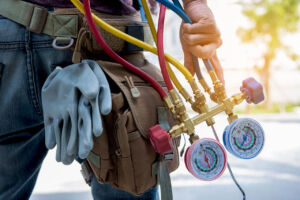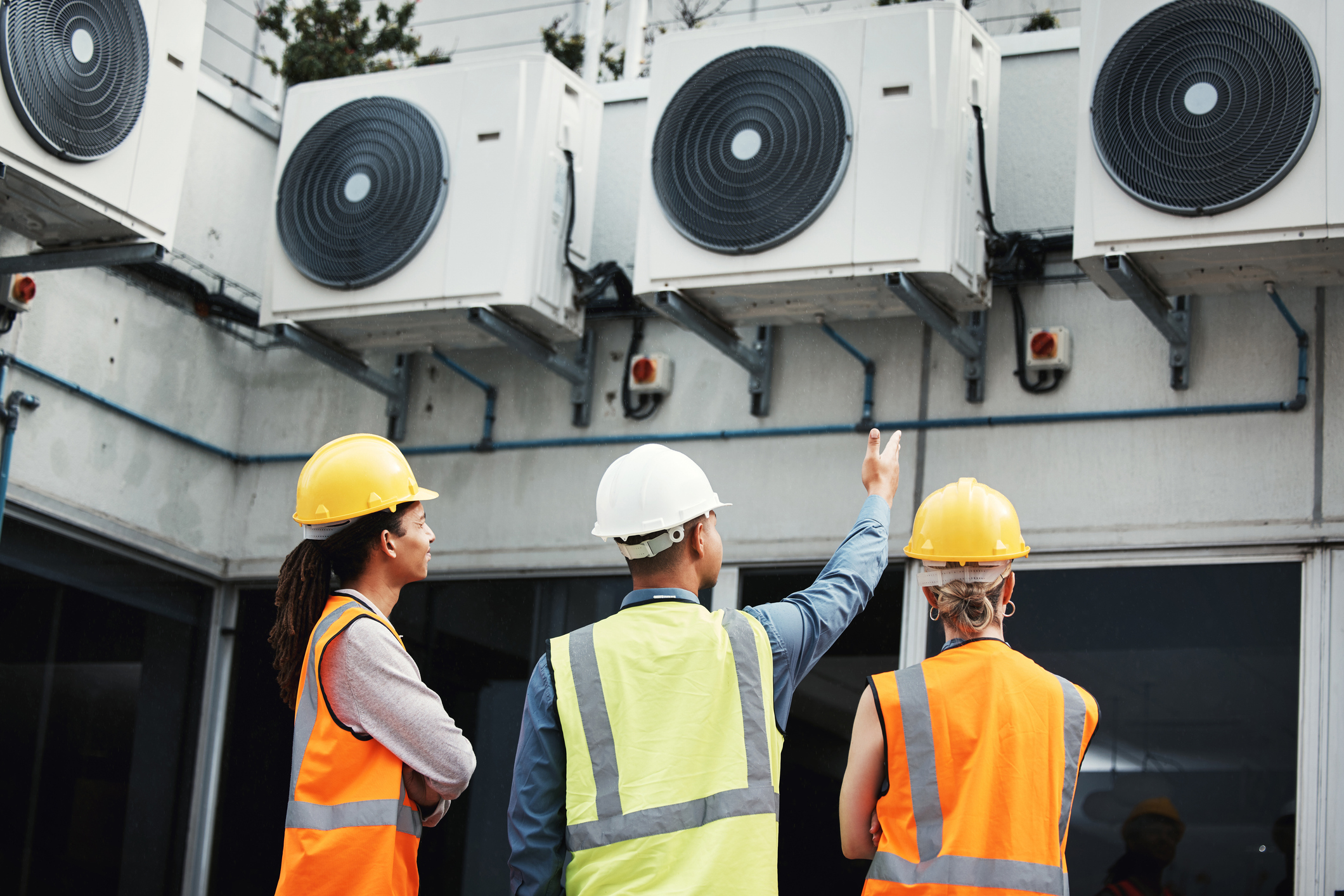Are you considering a career where you can work with your hands without sitting in an office? If so, consider becoming an HVACR technician. How do you prepare for this role? HVACR training gives you the skills to install, repair, and maintain HVAC systems in homes and businesses. Once you know more about what an HVACR technician does, you can understand why attending CyberTex is the best option. To help, we have put together this guide that will cover what you need to know about starting HVACR training.
What Does an HVACR Technician Do?
If you’ve ever adjusted the thermostat on a hot summer day or enjoyed a warm home in the winter, you have an HVACR technician to thank. HVACR (Heating, Ventilation, Air Conditioning, and Refrigeration) technicians install, maintain, and repair HVAC systems in residential, commercial, and industrial settings. Their work keeps homes and businesses comfortable year-round, ensuring good air quality and even preserving food and medical supplies through refrigeration.
Installation of HVACR Systems
One of the primary responsibilities of an HVACR technician is installing heating and cooling systems. This includes air conditioners, furnaces, heat pumps, boilers, and ventilation systems. HVACR technicians read blueprints, determine system requirements, and make sure that all components, such as ductwork, electrical wiring, and refrigerant lines, are correctly connected. They must follow industry safety standards and local building codes to ensure installations are safe and efficient.
System Maintenance and Inspections
Regular maintenance is crucial for HVACR systems to run efficiently. HVACR technicians perform periodic inspections, clean components, check refrigerant levels, and replace worn-out parts to prevent breakdowns. These maintenance tasks help improve energy efficiency and reduce costly repairs. Many people schedule annual service visits to keep their systems running smoothly, making preventative maintenance a key part of an HVACR technician’s job.
Diagnosing and Repairing Issues
When an HVACR system isn’t working correctly, it’s up to the HVACR technician to diagnose and fix the problem. This might involve troubleshooting electrical components, fixing refrigerant leaks, repairing motors, or replacing damaged parts. HVACR technicians use specialized tools to measure airflow and detect system malfunctions. Quick and accurate problem-solving is essential, as many repairs must be done promptly, especially during extreme weather conditions when heating or cooling is critical.
Working with Refrigeration Systems
In addition to heating and cooling, HVACR technicians work with refrigeration systems in restaurants, grocery stores, hospitals, and industrial facilities. These systems keep food fresh and help preserve medical supplies. Refrigeration technicians install, maintain, and repair walk-in coolers, freezers, and ice machines, ensuring they operate at the correct temperatures.
Customer Service and Communication
Beyond technical skills, HVACR technicians interact with customers. Good communication skills are essential, whether explaining repairs or answering questions about energy efficiency. HVACR technicians must clearly explain complex systems and provide helpful advice to homeowners and business owners.
A Hands-On, In-Demand Career
HVACR technicians enjoy a work environment that takes them to different locations and challenges them with new tasks. With the increasing need for energy-efficient HVAC systems, skilled HVACR professionals remain in demand. If you enjoy working with your hands and directly impacting people’s comfort and safety, becoming an HVACR technician could be the perfect career path for you.
Why Become an HVACR Technician
If you’re looking to become an HVACR technician and start a career that offers job stability, variety, and the satisfaction of helping people, becoming an HVACR technician is a great choice. With everyone’s reliance on HVAC systems year-round, skilled HVACR professionals are always in demand.
A Career with Job Security
Heating and cooling systems aren’t a luxury; they’re a necessity. Regardless of the season, people need their HVAC systems to run smoothly, which means HVACR technicians have steady work. The growing focus on energy efficiency and smart technology also means new and updated systems will continue to be installed, creating even more job opportunities.
Work That’s Hands-On and Rewarding
If you like working with your hands, solving problems, and staying active, HVACR is an ideal career. Every day presents new challenges, from troubleshooting malfunctioning systems to installing brand-new equipment. Whether repairing an air conditioner during a heatwave or ensuring a refrigeration system keeps food fresh, your work directly impacts people’s lives.
A Career Path Without a Four-Year Degree
Unlike many careers requiring years of college, HVACR training focuses on practical skills that can be learned in months rather than years. The HVACR program at CyberTex provides hands-on training and certification prepartion.
What Training Will Prepare Me to Become an HVAC Technician?
CyberTex offers an HVACR training program that gives you the skills and knowledge you need to succeed in this in-demand field. Our program focuses on practical training that prepares you for installation, maintenance, and repair work in residential, commercial, and industrial settings.
Hands-On Training for Real-World Skills
At CyberTex, we believe in learning by doing. Our HVACR training program provides hands-on training with industry-standard equipment, giving you the confidence to work on real HVAC systems. You’ll learn how to install heating and cooling units, troubleshoot electrical components, handle refrigerants safely, and perform essential maintenance tasks. Our industry experienced instructors are ready to teach you the skills employers are looking for.
Certification Preparation
Employers often look for HVACR technicians with the proper certifications. At CyberTex, we help prepare you for these industry certifications, including the EPA 608 Certification required for handling refrigerants. These credentials can help set you apart and make you more competitive in the job market.
What are Some of the Courses in the HVACR Program?
Students enrolled in the CyberTex HVACR training program will take a series of courses that build foundational skills, and industry knowledge. Below is a list of classes that are included in the HVACR program at CyberTex:
Introduction to HVACR
Learn the basics of heating, ventilation, air conditioning, and refrigeration systems, including how they work and their importance in residential and commercial settings.
HVACR Safety and Tools
Learn workplace safety practices, proper tool and equipment handling, and industry standards to prevent injuries and accidents.
Electrical Fundamentals for HVACR
Teaches students about electrical circuits, wiring, and troubleshooting electrical components in heating and cooling systems.
Refrigeration Systems and Components
Introduces the principles of refrigeration, including refrigerants, compressors, condensers, evaporators, and how cooling cycles work.
Heating Systems and Boilers
It focuses on different types of heating systems, including furnaces, boilers, and heat pumps, and how to install, maintain, and repair them.
Air Conditioning Systems and Maintenance
Covers air conditioning units, cooling load calculations, airflow dynamics, and proper maintenance procedures to ensure system efficiency.
HVAC System Installation
Teaches step-by-step installation processes for heating and cooling units, including ductwork, piping, and electrical connections.
Air Distribution and Ductwork Design
Covers the principles of air distribution, duct design, and how to optimize airflow for maximum efficiency and comfort.
EPA 608 Certification Preparation
Prepares students for the EPA 608 Certification Exam, which is required for handling refrigerants legally.
HVAC Troubleshooting and Repair
Focuses on diagnosing common HVACR system problems, performing repairs, and using diagnostic tools effectively.
Energy Efficiency and Green Technologies
Explores energy-saving technologies, smart HVACR systems, technologically advanced thermostats, and environmentally friendly heating and cooling solutions.
Commercial Refrigeration Systems
Covers specialized refrigeration units used in grocery stores, restaurants, and industrial applications, including walk-in coolers and freezers.
Final Capstone Project and Career Readiness
Students apply everything they’ve learned in a hands-on project to help them enter the workforce.
How Long is HVACR Training?
At CyberTex Institute of Technology, the HVACR training program can be completed in as little as 11 months of full-time study. The program offers flexible scheduling for day and evening classes to accommodate students’ needs.
What are the Benefits of Formal HVAC Training?
Getting formal training can give you a strong start if you’re considering a career as an HVACR technician. While some people try to learn on the job, enrolling in a structured program, like the one at CyberTex, provides many benefits to help you build a successful career.
Hands-On Experience with Industry Equipment
One of the most significant benefits of formal HVAC training is working with industry-standard equipment in a controlled learning environment. Instead of trial and error on the job, you’ll get to practice installation, maintenance, and repair skills under the guidance of experienced instructors.
Faster Career Readiness
Unlike four-year degrees, an HVACR training program at CyberTex can be completed in as little as 11 months. This means you can gain the skills and knowledge you need to enter the workforce quickly and start building your career sooner.
Certification Preparation
Many employers require HVAC technicians to have EPA 608 Certification, which is essential for safely handling refrigerants. A formal training program helps prepare you for this certification, making you more competitive in the job market.
Stronger Job Opportunities
Graduates of formal training programs often have better job prospects because they have verified skills and knowledge. Employers value candidates who understand HVACR systems, and safety protocols.
A Structured, Supportive Learning Environment
At CyberTex, you receive guidance from experienced instructors, access to modern equipment, and structured coursework designed to build your confidence. This creates a strong foundation for success in the HVACR industry.
What are Some Common HVAC Terms?
During an HVACR training program, you will learn the common HVAC terms that you will need to successfully complete your job. Here are a few terms to get you started:
Air Handler – A device that circulates and regulates air as part of an HVAC system, typically containing a blower, heating/cooling elements, and filters.
BTU (British Thermal Unit) – A measurement of heat energy; one BTU represents the amount of heat needed to raise the temperature of one pound of water by one degree Fahrenheit.
CFM (Cubic Feet per Minute) – A unit measuring the airflow volume in HVAC systems, indicating how much air moves through a system per minute.
Compressor – A key component in an HVAC system that pressurizes refrigerant to facilitate heat exchange.
Condenser Coil – The coil in an air conditioning or refrigeration system where refrigerant releases heat and condenses from a gas back into a liquid.
Refrigerant – A chemical substance used in HVACR systems to absorb and transfer heat, enabling cooling. Common types include R-410A and R-134a.
Thermostat – A device that controls the temperature of a space by signaling HVAC systems to heat or cool as needed.
Ductwork – A network of air passages that distribute heated or cooled air throughout a building.
Heat Pump – A system that provides both heating and cooling by transferring heat between indoor and outdoor air.
Evaporator Coil – A component in air conditioning systems where the refrigerant absorbs heat, cooling the air before it circulates into a building.
SEER (Seasonal Energy Efficiency Ratio) – A rating that measures the efficiency of air conditioners and heat pumps; higher SEER ratings indicate greater efficiency.
AFUE (Annual Fuel Utilization Efficiency) – A rating that measures the efficiency of a furnace in converting fuel into heat.
HVAC Load Calculation – A method used to determine the heating and cooling capacity needed for a building.
Expansion Valve – A component that regulates refrigerant flow into the evaporator coil to control cooling efficiency.
Latent Heat – The heat energy absorbed or released during a phase change (e.g., when refrigerant evaporates or condenses) without changing temperature.
Superheat – The temperature increase of refrigerant vapor above its boiling point, ensuring efficient operation of the system.
Subcooling – The cooling of refrigerant below its condensation temperature, increasing system efficiency.
Capacitor – An electrical component that stores and releases energy to help start and run the HVAC system’s motors.
Filter Drier – A device in HVACR systems that removes moisture and contaminants from the refrigerant to protect the system.
HVACR Zoning – A system that divides a building into different climate control areas, allowing customized temperature settings for improved efficiency and comfort.
HVAC Technician Diploma
Want to achieve HVAC certifications to start a rewarding career as an HVAC technician in Texas? With more than two decades of success in the medical, health, and IT sectors, we added an HVAC course to our curriculum. We proudly announce that we have flexible day and evening classes for the HVAC program.
CyberTex’s HVAC program can be completed in as little as 11 months by attending full-time with the flexibility of day and evening classes. You can take the EPA–608 certification from the US Environmental Protection Agency with our training.
Want to learn more? Contact us today.





